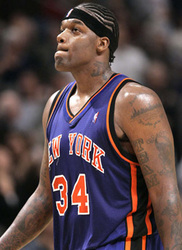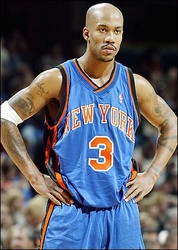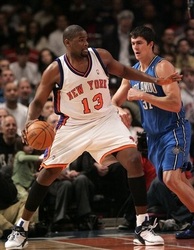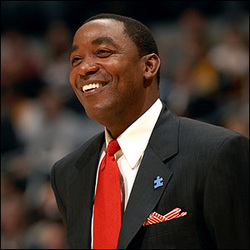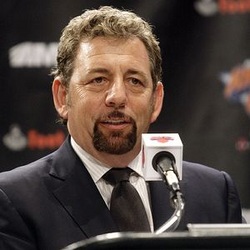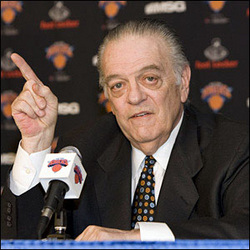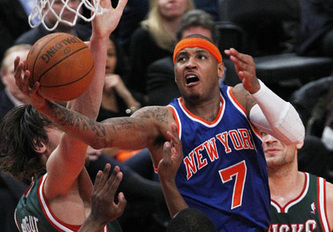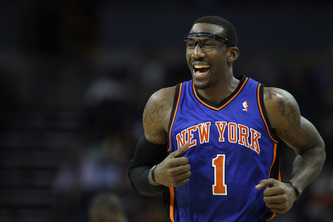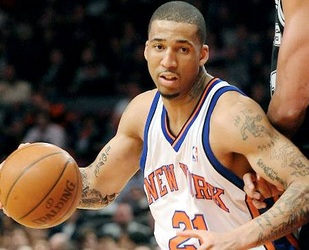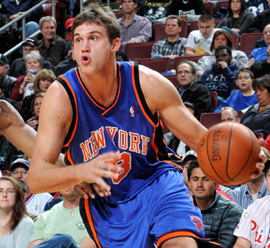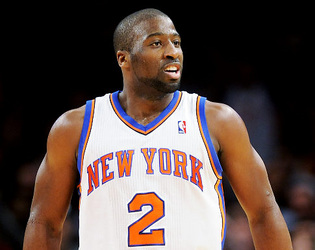RECOVERY
2010 New York Knicks
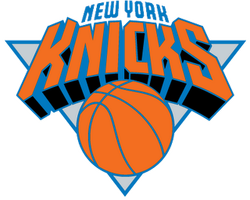
Disappointment. Failure. Losers. These are often the words to describe the state of the 21st century New York Knicks basketball team of the National Basketball Association. How does this team not make the playoffs since 2004? How does this proud organization not win a playoff game since 1999? Why was New York City, the world's capital of "street ball," burdened with a mediocre professional team? While there are a range of people who blame many different factors, the Knicks plummet at the turn of the century can be most attributed to the three following factors: money, talent, and poor decisions.
Patrick Ewing
Selected in the 1985 draft 1st overall by the New York Knicks, Patrick Ewing went on to become a superstar and helped to make the Knicks an elite team throughout the 1990s. While never winning a championship with his team, Ewing was able to keep the Knicks in championship contention nearly every year. However, when Ewing departed, a period of underachievement and bad decisions plagued the team throughout the beginning of the 21st century. The Knicks commenced an infamous route to becoming a laughing stock throughout the country.
Money and the Salary Cap
The majority of the Knicks problems can be attributed to going over the Salary Cap that they were allotted. In the NBA, when a team hands out salaries that exceed the Cap, they must pay a luxury tax to the league. The tax is equal to the number of dollars that the team went over, counted at the end of the season. While many teams have had success while going over the salary cap to keep their star players, many teams, like the Knicks, handed out outrageous contracts to former stars or role players. After the 2006-2007 season, the Knicks's salary cap was 45.1 million dollars over the tax line of 65.42 million dollars. Therefore, the Knicks owner, Jim Dolan, was forced to pay an extra 45.1 million dollars to the league, along with the huge contracts handed out to undeserving players. Considering that no other team payed more than 8 million dollars that year, the Knicks went from basketball's most profitable franchise to the franchise with the biggest debt. Only before the 2010 season were the knicks cleansed of these contracts and on the road to a profitable team as with the 90's.
The Management
In any sport, when a team is not winning, a majority of the blame usually gets put on the manager or coach of that team. While it's the players' faults if they do not play well, fans, who are often connected to the player's personalities and styles of play, tend to blame that grumpy looking person in a suit that is deemed the person that will bring his/her team to a championship. When it comes to Isiah Thomas, however, much of the blame throughout his coaching tenure is justifiable. Initially hired as the president of the Knicks's basketball operations in 2003. Just two years later, the team was in debt and in last place, there immediate future sunk in bad trades and contracts.
The Recovery Process
Once Isiah Thomas was fired in 2007 by then new general manager, Donnie Walsh, the recovery process slowly began for the Knicks. Instead of signing more big contracts and attempting to contend, Walsh let the then current large contracts of the team, such as those of Eddy Curry and Stephon Marbury, run out and free up cap space. Because of this newfound cap space and money to spend, the Knicks were able to sign free agent star forward, Amar'e Stoudemire, to a maximum contract. Not only was he a most valuable player candidate throughout the first half of the season, Stoudemire carried the team out of mediocrity and out of the cellar of the Eastern Conference to territory where they were when they made the playoffs back in the 90's. Not only was Walsh able to sign a star, such as Stoudemire, that is currently in his prime, Walsh had made several under the radar moves that improved the team as a whole. A star forward would be unable to do anything if he had nobody to pass him the ball. Walsh was able to sign a solid point guard/facilitator, Raymond Felton, to an affordable short term contract (2 years). Walsh's selections in the draft (Wilson Chandler 2007, Danilo Gallinari, 2008) proved that they could play at the NBA level. While they might not have been stars, they were solid role players that started 2010 off with great performances, thus raising their stock, or value. This enabled the Knicks to trade for one of the most recognizable scorers in the NBA, sending Chandler, Gallinari, Felton, and others to the Nuggets in exchange for Carmelo Anthony, Chauncey Billups, and others. In his span of general manager from 2007-2010, Walsh cleared up the salary cap, drafted solid young talent, and acquired two superstars that could lead any team they play on to a championship. These moves resulted in the Knicks first playoff appearance since 2004 and their first winning record since 1999.
While the Knicks were eventually eliminated in the first round by the Boston Celtics, their future is bright. With two true superstars, Amare Stoudamire and Carmelo Anthony, and a possible third on the horizon, the Knicks are nearly done recovering from their losing ways. The fans of New York are eager to bring the championship trophy back to Madison Square Garden for the first time since the 1970s. However, with the unpredictability of the sports world, will we know for certain that the New York Knicks will revive their status as an elite basketball team? Only in time will we know the answer.
While the Knicks were eventually eliminated in the first round by the Boston Celtics, their future is bright. With two true superstars, Amare Stoudamire and Carmelo Anthony, and a possible third on the horizon, the Knicks are nearly done recovering from their losing ways. The fans of New York are eager to bring the championship trophy back to Madison Square Garden for the first time since the 1970s. However, with the unpredictability of the sports world, will we know for certain that the New York Knicks will revive their status as an elite basketball team? Only in time will we know the answer.
